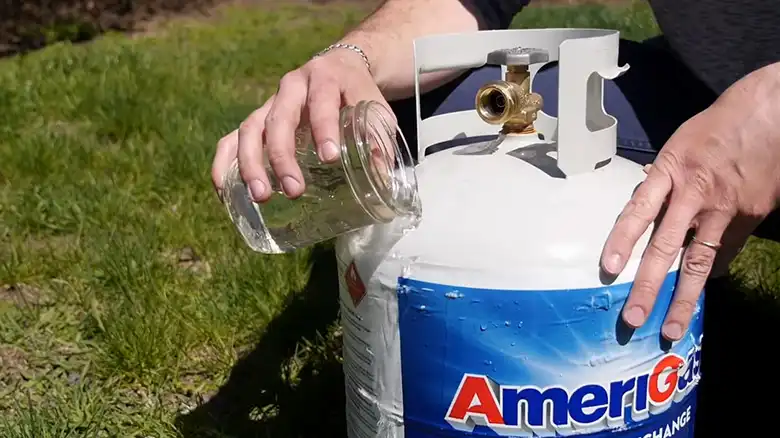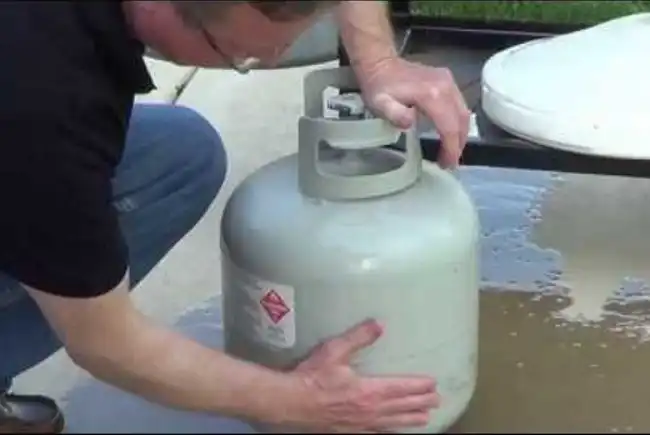Having enough propane while RVing is crucial for cooking, heating water, and powering certain appliances. Running out of propane mid-trip can be inconvenient and disruptive to your travel plans. That’s why it’s important to regularly check your RV’s propane tank level.
RV propane tanks come in different sizes, from small 5-gallon portable tanks to large 40-gallon permanent mounted tanks. Most RVs have at least one propane tank mounted to the frame. The tank has a service valve that connects to the RV’s propane distribution system via copper tubing and regulators.

How to Check Propane Levels in Your RV Tank?
RV propane tanks contain liquid propane under high pressure. The pressure pushes the propane out in vapor form to power appliances. Tanks have a float gauge, service valve, bleeder valve, and pressure relief valve.
The float gauge indicates the fuel level. The service valve attaches the tank to the RV’s distribution lines. The bleeder valve releases pressure from the tank. The pressure relief valve prevents unsafe pressure buildup. Below are some common ways to determine your RV’s onboard propane tank levels.
Simple Visual Inspection Methods

Looking at the Tank Gauge
If your RV propane tank has a float gauge on top, you can visually inspect the position of the float through a clear window. The position corresponds to the tank’s fuel level. However, float gauges can get stuck and provide inaccurate readings.
Observing Bubble in Sight Glass
Some RV propane tanks have a sight glass with a liquid chamber on the service valve. When you partially open the service valve, gas bubbles through the liquid. Watch the frequency of the bubbles – fast bubbling indicates a high fuel level, and slow bubbling means the tank is near empty.
The Hot Water Technique for Tank Level Estimation
With the propane tank service valve fully open, turn on a hot water appliance like the stove burner or water heater. If hot water flow or burner strength decreases noticeably after 5-10 minutes, this likely means the propane tank is less than 30% full.
This decline occurs once the remaining liquid propane transitions to gas, reducing pressure. The hot water method gives a good ballpark estimate of lower tank levels.
How to Accurately Weigh Your Propane Tank
Weighing the RV propane tank gives the most accurate fuel level reading. Subtract the tank’s empty weight (usually stamped on the tank) from its current gross weight. Then compare the calculated net propane weight versus the tank’s capacity to find the percentage full.
For example, a 30 lb. tank empty weighs around 17 lbs. If the gross weight on a scale is 47 lbs, then the net propane weight is 30 lbs. So the tank is 100% full. If the gross weight was 37 lbs, the net propane weight was 20 lbs. Meaning it’s 2/3 or 67% full.
Weighing requires a large portable scale. So it’s more practical with small removable tanks versus large permanently mounted ones.
Remote Propane Monitoring with Tank Sensor Monitors
Aftermarket and factory-installed propane tank monitors use sensors to detect liquid levels and remotely display fuel status.
RVT500 Tank Monitor by TankTenders
The RVT500 attaches to your RV’s propane tanks and uses ultrasonic sensors to measure fuel levels. It transmits the data via Bluetooth to your phone or tablet up to 100 feet away. You can continually monitor propane levels from inside the RV. The RVT500 also alerts you if any connected tank drops below a preset threshold.
Dometic LP Gas Level Gauge
Many RV manufacturers offer the Dometic LP Gas Level Gauge as a factory-installed option. This display panel uses pressure transducers and temperature sensors on the tanks to calculate fuel levels. The percentage full is shown on a digital screen for convenient readout inside the RV.
Camco Magnetic Propane Gauge
Camco’s aftermarket magnetic gauge adheres to the tank exterior and visually indicates fuel level. The five-zone color display alerts you whenever the propane level drops below 20 percent capacity.
Why Checking Propane Levels Is Important?
Regularly monitoring your RV’s propane levels is crucial for various reasons. It helps prevent unexpected depletion, ensuring you have an adequate supply for essential tasks like cooking and heating. This practice also allows you to gauge whether a propane refill is necessary before embarking on a trip or reaching a destination where refilling might be challenging. Additionally, consistent checks enable the early detection of potential leaks, as abnormal and rapid decreases in tank levels may signal underlying issues that require attention.
RV propane tanks contain liquid propane under high pressure, around 150 psi. This pressure pushes the propane out in vapor form to appliances. Tanks have a float gauge to indicate fuel level, a service valve to connect to distribution lines, a bleeder valve to release pressure, and a pressure relief valve to prevent unsafe pressure buildup.
How to Handle Inaccurate Propane Readings?
Propane tank level gauges can sometimes malfunction or display the wrong fuel status. If the gauge conflicts with other tank indicators or your usage experience, the following tips may help confirm the actual level –
a) Visually inspect tanks for frost, which signifies ample propane.
b) Use the hot water method to check for declining appliance performance.
c) Weigh tanks or have them certified if adjustable gauges seem unreliable.
d) Monitor usage rates over a few days.
In some cases, a faulty or broken sensor/gauge will need replacement by a qualified RV technician.
When to Refill Your Propane Tank?
To keep your RV propane supply in check, it’s smart to plan refills strategically. If you’re on the road without hookups, consider topping up before the tank goes below 20% to avoid running out. When you’re in the 20-30% range, take advantage of available refilling stations for more frequent top-offs, making the most of each fill-up. Always refill before a trip or upon reaching a destination with no refilling options to prevent being stranded without propane. If you notice the fuel level is lower than usual, refill to rule out a potential leak. Lastly, refilling when there’s still 5-10% propane left allows room for expansion with temperature changes inside the tank.
Important Safety Precautions When Refueling RV Propane Tanks
Follow these important safety measures when refueling your motorhome or travel trailer propane system –
Step 1: Turn off appliances and pilot lights that use propane a minimum of 5 minutes beforehand. This allows residual gas to dissipate from lines.
Step 2: Shut the service valve on tanks already filled so only empty tanks receive fuel. Never overfill a warm tank since liquid expansion can dangerously exceed capacity.
Step 3: Avoid spilling propane on the skin or clothing. The extreme cold can cause frostbite. Keep the fill nozzle in contact with the tank opening when fueling.
Step 4: Position portable tanks upright on the ground before refueling. Make sure large mounted tanks have adequate ventilation.
Step 5: Check that tank fittings and O-rings are in good condition so valves close tightly after fueling without leaks.
Step 6: Inspect propane lines, controls, and appliances for leaks or issues after refueling using a leak detector solution or electronic sniffer devices.
Taking these steps when refueling helps prevent propane overflow incidents and preserves RV system integrity.
Top Bluetooth Propane Monitoring Sensors for RVs
The TankTender RVT500 is the best Bluetooth RV tank monitor. It wirelessly displays propane levels from multiple tanks up to 100 feet away right on your mobile device. The RVT500 ultrasonic sensor straps onto your existing tanks, requires no wiring and alerts you when any tank dips to low levels. Its long-range and integrated alerts make tank level monitoring simple and hassle-free.
Frequently Asked Questions
What is the pressure of propane in an RV?
Propane is stored as a liquid under high pressure of about 150 psi in RV tanks. It converts to a gas vapor when released to appliances operating at low pressures of 11″ to 14” water column.
Why does my propane tank feel full but has no gas?
This usually results from air trapped in the lines or a stuck regulator not allowing the release of propane vapor. Bleeding valves to discharge the air pockets or replacing faulty regulators will restore proper gas flow.
What happens if the propane tank is left on?
Continually open valves allow propane vapor to release and accumulate inside the RV, creating a dangerous fire/explosion risk if ignited by a spark or appliance burner. Always close the service valve on tanks not actively being used.
What’s the difference between LP and propane?
LP gas refers to all flammable gas products like propane, propylene, and butane used for heating/cooking. So propane is technically an LP gas, but not all LP gases are pure propane.
How many hours does one propane tank last?
Propane tank duration depends on size, usage rate, and appliances. On average an RV refrigerator can operate 50-80 hours on a 30 lb. tank while a furnace may use a 30 lb. tank in less than 10 hours. Careful monitoring of tank percentage usage over time allows you to calculate expected runtime.


